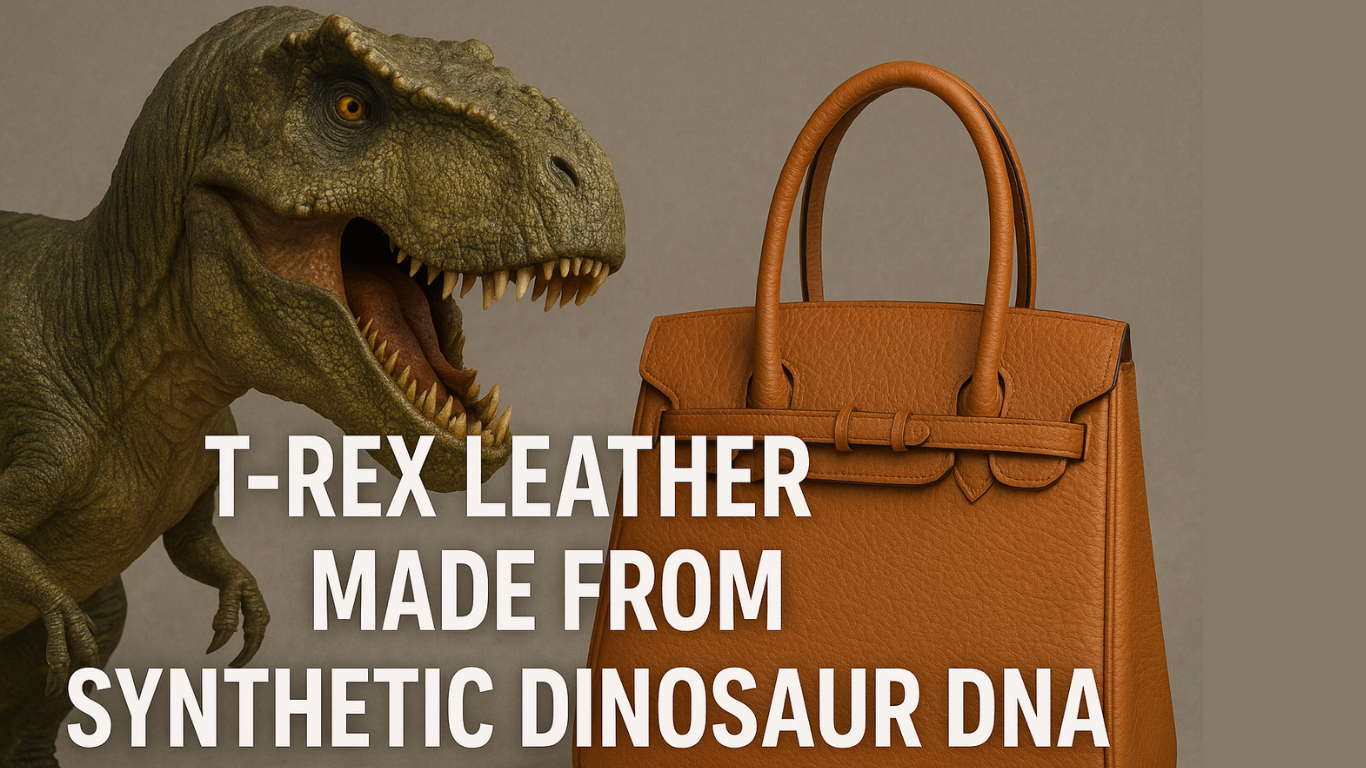A group of biotech innovators and creative agencies has kicked off an ambitious project to create the first lab-grown ‘T-Rex-inspired leather.’
They are planning to pull collagen peptides from 66-million-year-old fossils, use AI to reverse-engineer possible dinosaur DNA sequences, and apply some cool cell-culture techniques to make a high-quality, sustainable leather alternative.
This project could shake up luxury fashion and advance biomaterials science, but it’s also sparked some intense debates about its scientific credibility, the technical challenges involved, and the ethical issues it raises.
Lab-Grown Leather and Synthetic Biology
Over the last decade, biofabrication has become a solid alternative to traditional animal hides. This allows the creation of collagen-based materials without the need for livestock or harmful tanning processes.
Many companies have shown that cultured animal cells can come together to form dense collagen structures that really resemble the structure of real leather. These so-called ‘vegan’ leathers have some serious sustainability perks:
– They help reduce deforestation.
– Cut down on greenhouse gas emissions
– Get rid of the toxic chrome-based tanning chemicals used in regular leather production.
Synthetic biology tools like CRISPR for gene editing and AI-driven protein design have really expanded our ability to create new biomaterials.
Thus, researchers can now tweak protein sequences at the genetic level, which allows them to customize things like strength, flexibility, and how eco-friendly materials are for different uses, no matter if they are for industrial or for everyday products.
This mix of paleontology, genetics, and materials science is paving the way for the T. rex leather project.
The T. rex Leather Initiative
● Consortiums and Partnerships
In April 2025, three companies teamed up to create the world’s first ‘T. rex leather.’ The Organoid Company from the Netherlands is using its gene-engineering tech for synthetic gene design, while Lab-Grown Leather Ltd. from the UK is focusing on assembling collagen without scaffolding.
In the U.S., VML, a creative agency, is handling branding and marketing strategies. They have got a talent for creating buzz with their campaigns, like the viral ‘mammoth meatball’ stunt, proving they really know how to blend cool science with smart marketing.
The team plans to roll out prototypes—like fancy handbags, watch straps, and car interiors—by the end of 2025. They are aiming to catch the attention of upscale fashion brands and niche car companies that really value fresh ideas and eco-friendly options.
● Fossil Collagen and Protein Analysis
While complete dinosaur DNA has been missing for around 66 million years since the non-avian dinosaurs went extinct, paleontologists have managed to find some preserved collagen peptides in really well-preserved fossils. These tiny pieces of amino acids are protected by cross-links at the atomic level, which helps them stick around in fossilized bones. Scientists can study these peptides using high-resolution mass spectrometry to uncover parts of the collagen sequences.
The project kicks off by looking at old protein studies and matching the peptides found with collagen from today’s birds and reptiles. Then, using phylogenetic models, it fills in the missing pieces to create a guess of what the original protein sequence was like. This serves as the base for designing synthetic genes.
Synthetic Dinosaur DNA: From Peptides to Genes
● Paleoproteomics and Collagen Sequencing
The first step is to snag some tiny bone samples from top-notch T. rex fossils, making sure everything stays super clean to prevent any contamination. After that, scientists use tandem mass spectrometry to break the proteins down into smaller bits. They then check these pieces against big protein databases to confirm that they really come from dinosaurs.
Bone collagen and skin collagen are structured differently, with the fibers in each being arranged and linked in unique ways. To figure out which sequences are more common in skin tissue, researchers rely on some statistical methods and evolutionary tricks. But there is a bit of guesswork involved in this process.
● AI-Driven Gene Reconstruction
Once a provisional collagen sequence is set up, deep-learning algorithms take the amino acid chains and turn them into suitable nucleotide sequences, making sure to optimize for the specific codon usage of the host cells, like those from mammalian or insect cultures. These synthetic DNA pieces feature promoter regions, enhancers, and termination signals that are designed to boost the collagen protein’s expression levels.
The plasmids or viral vectors are put into cell lines using methods like transfection or infection. This way, the cells incorporate these synthetic sequences into their genomes, which allows them to continuously produce collagen in a controlled environment like a bioreactor.
Scientific Skepticism and Challenges
Even with all the buzz, many paleontologists and molecular biologists are still pretty skeptical. To date, no real dinosaur DNA has been successfully sequenced—DNA starts to break down pretty fast, usually after about 1 to 2 million years, even in the best situations. The oldest verified sample we have is only about 1.6 million years old, coming from Greenland, and it’s not even from a dinosaur.
Also, all the dinosaur collagen we have found so far comes from bone, not skin. That makes it pretty tricky to directly compare it to leather. Plus, collagen is a protein that’s super similar across all vertebrates, so even small changes in its structure probably won’t make it that different from the lab-grown bovine collagen we’ve got now.
Market Prospects and Industry Impact
VML is expecting luxury prototypes, like handbags and watch straps, to hit the market by late 2025. This could be exciting for high-end brands looking for something fresh and eco-friendly. The car industry is also a possible market—fancy car makers might start using materials that offer a blend of ancient toughness and modern sustainability in their interiors, promoting their vehicles as the best of both worlds.
Prices for the initial units are expected to be sky-high—possibly thousands of dollars per square foot—because of the research and development costs and the complexity of biomanufacturing. Still, supporters are hopeful that as things scale up, bioprocesses get better, and synthetic biology advances, the costs will drop over the next five to ten years.
Conclusion
In the end, the T. rex leather project blends science, marketing, and creativity. Even if we can’t get 100% authentic molecular material, it highlights the amazing possibilities that come from mixing paleontology with synthetic biology.
It encourages us to rethink where our materials come from and the boundaries of our creativity—hinting that soon enough, pieces of the Jurassic era might make their way into the wardrobes of environmentally conscious shoppers.



